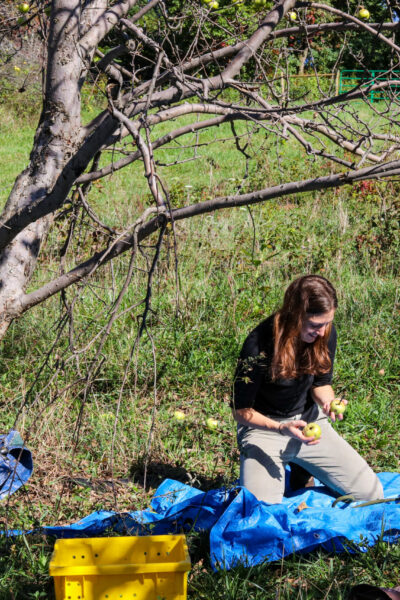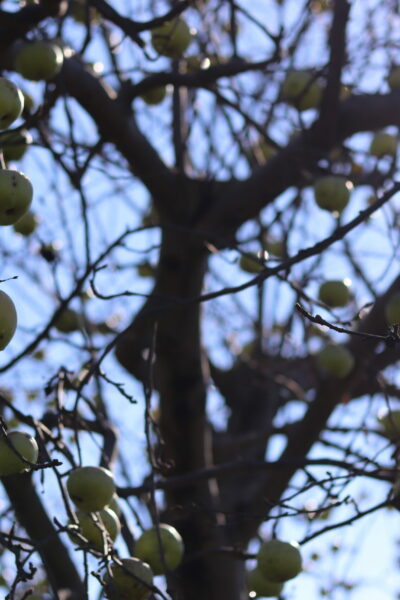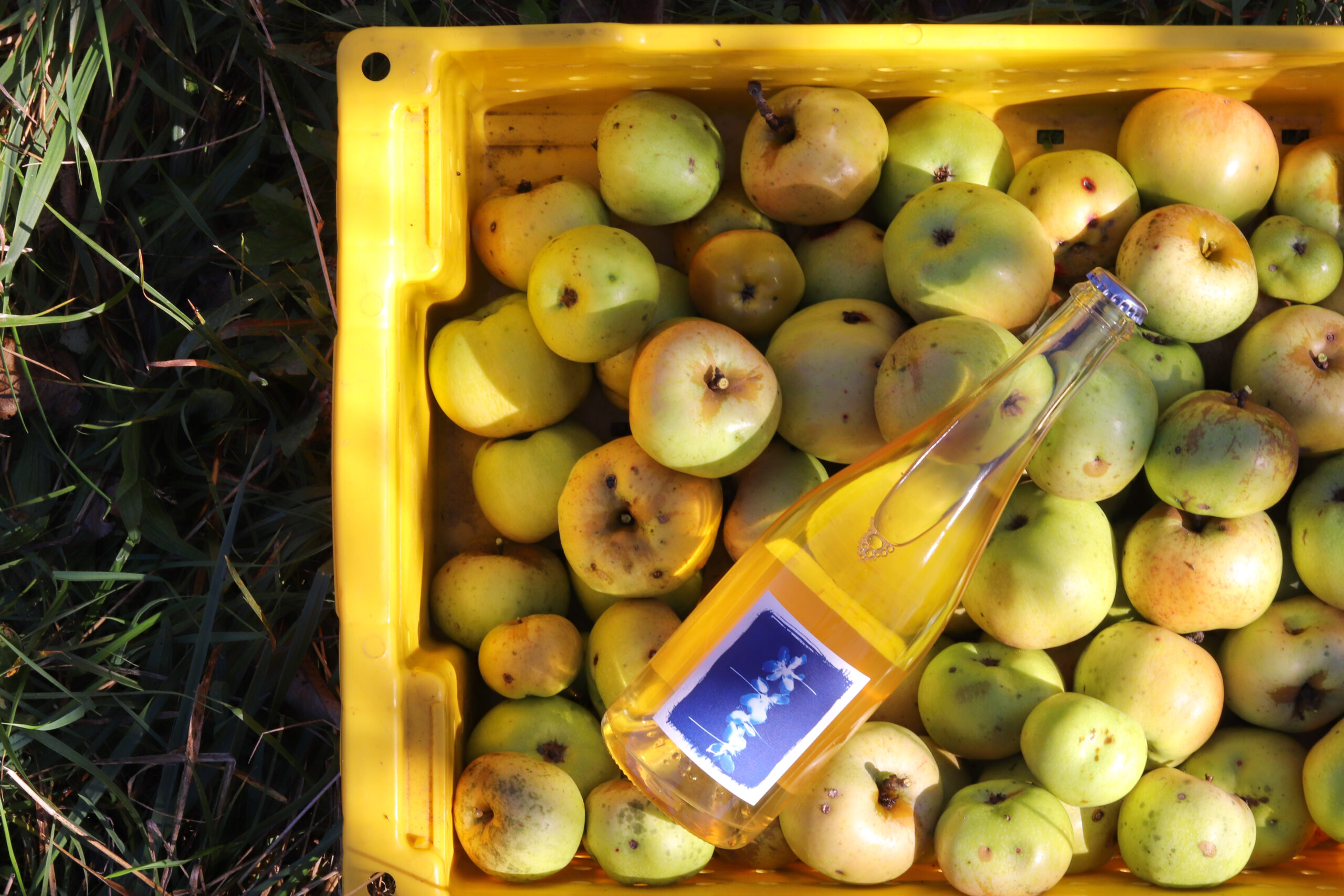
WORDS | Lisa Archer PHOTOS | Leigh McDonald
The apple is yellow-green —underripe— and freckled with tiny scabs. I can see where a yellow jacket has bitten a chunk out of it, but instead of giving in to rot, the fruit has healed over — callused beneath my thumb, but whole. Sunwarmed, I hold the oblong fruit in my hand and regard a piece of our region’s history. This apple’s ancestors can be traced to Long Island, where it was planted in the 1700s by European settlers. By the mid 19th century, the apple had carved a home for itself here in the sandy soil of Bent Mountain, in southwestern Virginia, where, for a time, it was the prized, best-producing crop of the region.
The orchard I’m standing in, accompanied by Patrick Collins and Danielle LeCompte of Patois Cider, was once a flourishing family business, but now serves mostly just the family who owns it and the herd of cattle that graze alongside rows of apple trees.
“It’s beautiful to stumble on these old commercial orchards but it’s also a little sad — you know, walking past the infrastructure, that’s where their cold storage used to be and the bins are rotting out and you wonder, why is this not viable?” says Collins, as we dodge cow pies and survey trees — heavily-laden with fruit — on a clear October day.
Virginia was once home to swathes of small family orchards like this one. Varietals such as the Albemarle Pippin were an important export to Britain. Queen Victoria herself was known to favor brandy made with Bent Mountain Pippins. Over time though, large-scale commercial orchards took over the market and consumers turned to commercialized varieties, such as Red Delicious, McIntosh and Granny Smith: apples that fit the 1950’s A is for Apple poster. Perfect in shape and long lasting, albeit a bit bland. Varieties such as Pippin or Arkansas Black fell out of favor, and the orchards that produced them floundered. Today, if you are driving up route 220 or on a hike in the mountains, you may spy vestiges of old orchards or homesteads, with aged apple trees still producing fruit.
These are the trees Collins and LeCompte are interested in.
Collins’ interest in cider came from his restaurant and wine background. “I went to school and was working in Boston, he says. “Everybody at the time was homebrewing beer, and I was always confused by that, because you’re buying grain from the Midwest and you’re buying hops from the west coast or Europe and I was like, there all these old Baldwin apple orchards in western Mass[achusetts] that no one is utilizing, so I started making cider — a couple carboys [fermentation vessels] in the closet — and then I kinda got obsessed. Through exposure to small producers and particularly natural wines, I started to want to make beverages along the ethos of natural wine; ideologically it resonated with me, but I also thought they tasted better.”
Collins eventually settled in central Virginia, where he landed a job with Potter’s Craft Cider [this is where he and LeCompte met], fermenting alongside cidermaker Andy Hannas. After a few years, Potter’s production doubling with every fermentation, Collins was ready to start his own venture.
Knowing the rich history of apples in Virginia, and seeing fruit throughout the region that was going unpicked or altogether forgotten, Collins decided to focus his cider making on wild/foraged fruits, with the hypothesis that apples can express terroir as well as any wine. Patois cider is cider of a time and place; an expression of the fruit and its surrounding, versus a crafted/manipulated beverage. Patois cider-making follows the practices of natural winemaking; the nutrition of the juice is not supplemented, nor do they inoculate it with commercial yeast strains. Instead, they allow the naturally occurring yeast strains present on the unsprayed fruit skin to ferment the juice, allowing these apples, some varieties of which have survived for over 150 years, to fully express themselves as cider.
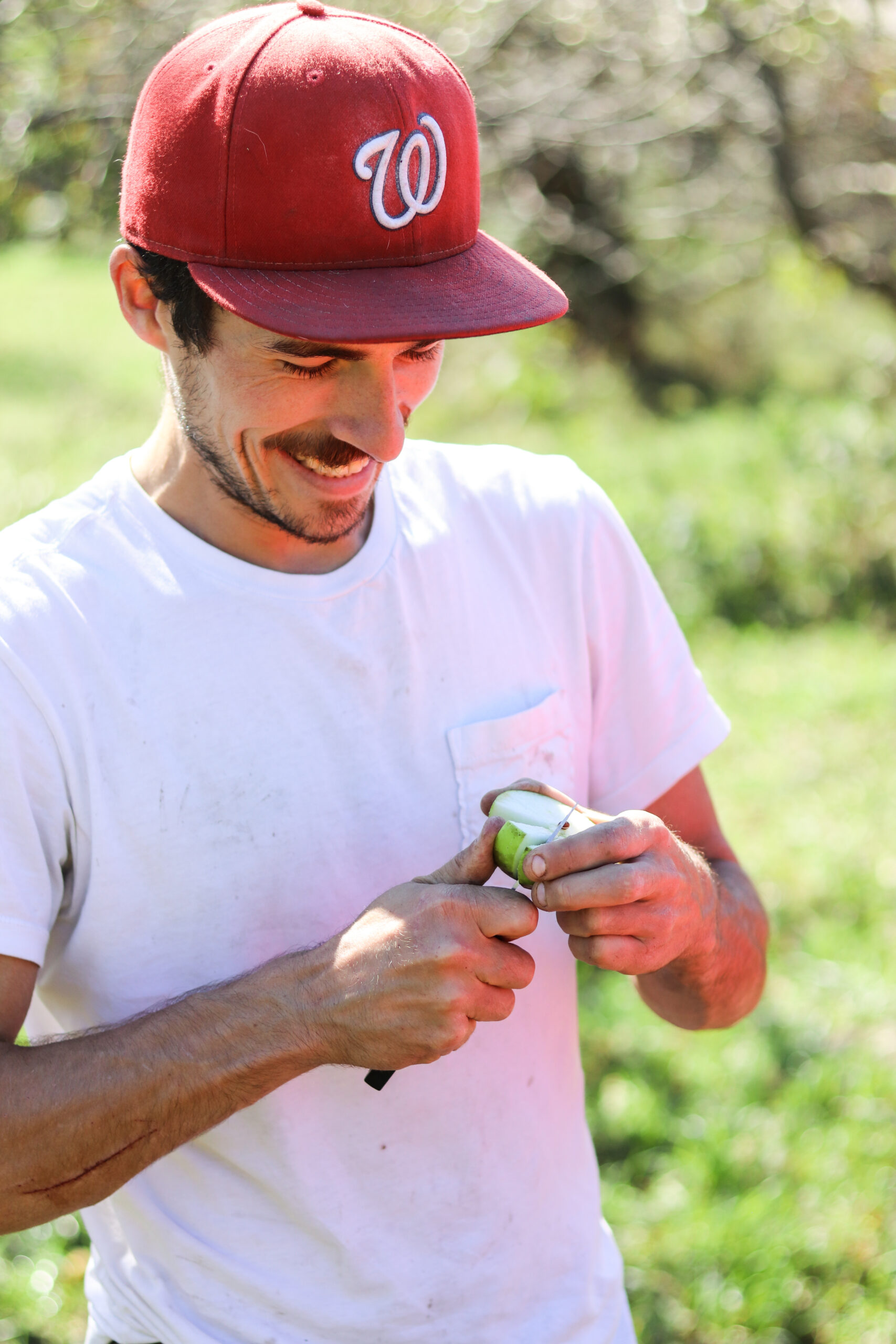
There are two prongs to finding harvest sites. Some spring days, Collins, LeCompte, and their terrier, Arty, will drive up old mountain roads, looking for the white blossoms that indicate apple trees, leaving handwritten notes in mailboxes when they find a promising one. Other days, Collins pores through historical records, looking for old orchard sites, or reading through horticultural society meeting minutes. Some folks reply to his inquiries, saying, yes, please come take the fruit away, it’s a nuisance, but more often than not, they will tell the story of the apple trees and those who planted them. It may be an old orchard that was in the family for years, as it is with Witt’s orchards — the Bent Mountain site — or that a grandfather planted a few trees in the backyard and his wife harvested and canned the fruit for decades, a beloved memory that now founders on the property.
These moments are about more than just the one-on-one connection; Patois cider is slowly building a community, one handshake and handwritten note at a time. With Patois in its third production season, people are now reaching out to Collins and LeCompte, telling them about old orchards that belong to a family member, or alerting them to the location of old homestead sites that now lie within the national forests and parks (with the creation of these parks, many homesteaders were forced out when the government seized their land).
“The old homesteads were not monocroppings, they were generally grown from seed or root cuttings,” Collins tells me. “Part of growing from seed is that it’s a genetic variability grab bag — apples aren’t true to seed — there’s a little more improvisatory way in which people would utilize what would spring up, it was very much like, that tree is good for drying, this tree is good for fresh eating, that tree is good for cider. Often these apples are far more interesting than anything that has been propagated for commercial production. There’s a plethora of genetic material that’s just up in the mountains. I think that, 100%, should be the future of cider fruit here in Virginia because these trees, no one is doing anything to them, and for whatever reason, whatever genetic chance they’ve developed a better sense for the stresses of the VA climate. You take a bite of them and taste this fruit and its electric.”
Harvest season runs August through November. During this time, Collins and LeCompte work 12+ hour days, seven days a week. They drive up and down the Shenandoah corridor, from the Bent Mountain site as the southernmost harvesting point, to Rappahannock County in the north. They hand pick apples, selecting for flavor, not always knowing the variety. “I don’t really care what the name of the apple is,” says Collins. “Is it healthy? Ripe? Am I picking it? I’m not much for the historical recording of, this is Thomas Jefferson’s favorite apple. I care about the integrity of the fruit itself in this time and place.”
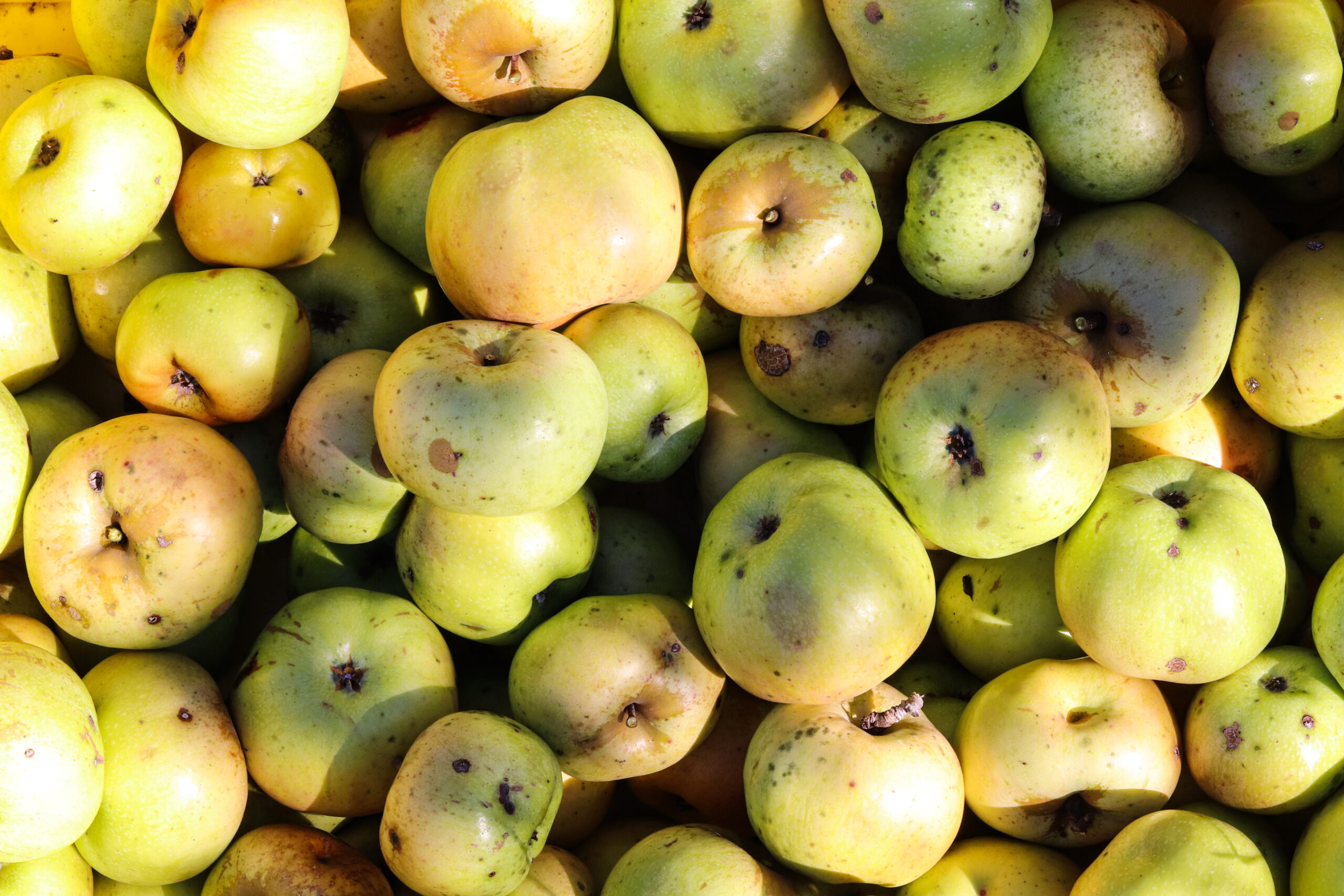
They transport their harvest in the back of their red Ford pick-up to either the farmhouse they rent in Crozet or to a shared production site in Charlottesville. There, the apples will sweat (ripen) for anywhere from a few days to two weeks, until the desired ripeness is achieved, and the fruit is full of juice. The fruit is then sorted again, and the lugs of apples are hoisted into the crusher. No pumps, no conveyor belt to lift the fruit; it’s all done by hand (LeCompte jokes with Collins that they should post a sign-up sheet at a nearby Crossfit gym to help with this part of the process). The juice is then fermented, bottled and labeled by hand (during the winter months, LeCompte and Collins sit by their wood stove, designing labels).
It may not seem viable, to have so many sites, work such long hours and drive so many miles, when larger cideries often source from just a few sites. However, with the variance in weather due, in part, to climate change, it allows Patois to always have fruit to harvest.
“I think having a wide network of fruit sources at various elevations at different soil types is something that, going forward, has to remain somewhat of a constant against variances like hurricanes or hail or a late frost coming through,” Collins tells me. To ensure the continued survival of the trees, Collins and LeCompte work with landowners to manage the sites: pruning some trees during winter to prevent them from growing into one another, encouraging the growth of positive microorganisms to compete with apple rust or blight, and planting trees for the future (one of the harvest sites belongs to the Terrys, the family that fought Mountain Valley Pipeline. Patois made a small batch single-site cider dubbed “Puck the Fipeline,” to raise bail funds for the Appalachians Against Pipelines organization. They also planted 100 seedling trees after the power company bulldozed trees on the Terry’s land, hoping to help replenish what was once there).
Collins’ goal is to have twenty or more sites that he can harvest from for the next 10-20 years (or for the rest of his cider-making days), producing single-site ciders which will allow him to determine how terroir is expressed in the apple. “I’m trying to learn as I harvest,” Collins says as he shakes apples from the tree and catches them on a tarp below. “I look around and say, why this site, why did they plant here … some of it is because this was the land they had, but it’s more than that, it’s understanding the relationship of the trees to their surroundings …I want our cider to be an invitation — as opposed to terroir as something that is exotic/other — I want people to realize you don’t have to purchase a bottle from France or somewhere else in order to experience it. That’s not true, it’s everywhere — it’s right here — you just have to be open to it.”
As we wrap up our conversation, we pause to taste a few apples (and a little cider). Collins slices an Albemarle Pippin, with its russeted shoulders gleaming in the sun, right through the middle, revealing the star-shaped seed chamber. He shows me how small the seed chamber is in comparison to the apple flesh, an indication the fruit is “all juice!” We each take a slice and it tastes of sugar and green tea, with a lemony finish that makes the sides of my mouth water. Collins sighs and says, “Now, that’s a fine piece of fruit.”


